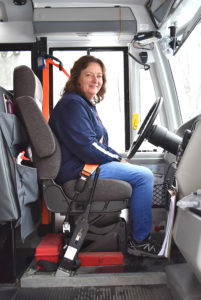
A gentle, steady hum emanates from a school bus idling outside Daniel Axford Elementary.
“That’s the heater you hear running,” explained Oxford Schools’ Transportation Director Ann Weeden, “not the bus.” A moment later she turned the heaters off. Then all that could be heard was the excited chatter of DA’s Green Team. But the bus was still running, Weeden assured them.
The electric bus is one of two that have been in service since the beginning of the year. The district recently acquired them with the help of a 70 percent subsidy provided by funds from Volkswagen as part of a settlement for violating the Clean Air Act.
The morning of Feb. 6, DA’s Green Team took one of the buses on a mini field trip around the block. The Green Team is a before-school club where students learn about sustainability.
The two new electric buses service Daniel Axford and Oxford Elementary schools. So, some of the Green Teamers already ride one every day. Weeden asked those students what they like about the new buses.
One child said he liked the touch screen built into the dashboard. “I like that sometimes it plays music,” another girl said.
“For those of you who don’t ride the electric bus, you’re going to hear a noise that this bus makes when it’s going very slow,” Weeden explained. It’s to let people know that the bus is in motion, since it is so quiet.
“Ding-Dong-Ding” was the only noise to be heard as the bus pulled out.

Weeden pointed out to the students that not only does the bus help reduce air-pollution, but it also helps with noise pollution. It didn’t take long for the din of excited schoolchildren to disrupt the silence.
After they got back, Weeden told the students she did some math and figured that it costs one fourth as much to power the bus compared to the diesel it replaced. “So a diesel bus is four times more expensive. That’s a lot.”
That figure is not just economic efficiency. It’s also a measure of energy efficiency, Oxford Schools’ head transportation technician Mark Hillebrand later explained. “People will have the argument that, ‘Well, you still got to burn coal to make the electricity.’ The thing about a gas engine is it’s 30 percent efficient. 70 percent of the energy is heat wasted. It’s not so much with an electric motor.”
The buses also have regenerative braking, so they harness some of the energy lost from the brakes.
Hillebrand thinks the efficiency will help pay for the upcharge since battery prices and infrastructure are still expensive. “Once that starts to level out, I think we’re all going to own electric vehicles.
Hillebrand’s favorite talking point is a fact he learned from a DTE Energy presentation.
“Between the hours of 11 p.m. and 5 a.m., they don’t sell hardly any electricity. Businesses are shut down. Very little electric heat is used. But, they can’t slow down their turbines. So, they’re burning the same amount of coal, the same amount of gas basically all night long and just throwing away that electricity.” Overnight is when the buses charge, so it’s helping store some of that energy.
One more advantage of the electric system is its low-maintenance. “You have a simpler power propulsion system,” Hillebrand continued. “There’s no transmission. There’s no exhaust. There’s only two moving parts in the motor, as opposed to a gas motor that has 2,000.”

Hillebrand has been instructed not to tinker with anything in the propulsion system, and it likely won’t need anything. “The biggest thing we’ll probably have to do if there is an internal problem with one of the battery cells, we’ll have to remove it and get it sent in to have it looked at.”
The complicated part of the vehicle is the software. “It’s kinda nice to be on the cutting edge. I kinda nerd out over it,” he said.
Weeden hopes the district will have more electric buses in the future. “Eventually I think the plan is to not totally switch over to electric buses, but at least add to the fleet.”
There are other grants available, she noted, even if the Volkswagen mitigation funds run out And they already have the infrastructure and wiring in place to charge two additional electric buses.
In the meantime, the neighborhoods in the village are going to be a little cleaner, if not quieter.

Leave a Reply